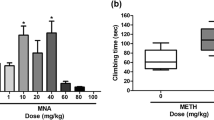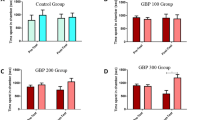Abstract
Rationale
MDMA is one of the most widely consumed recreational drugs in Europe. However, the mechanisms involved in the reinforcing properties of MDMA are still unclear. In this sense, the establishment of a reliable model of MDMA self-administration in mice could represent an important approach to study the neuronal substrates associated with MDMA reward by using genetically modified mice.
Objectives
To develop a reliable model of operant intravenous MDMA self-administration in drug-naïve mice.
Materials and methods
Mice were trained to acquire intravenous self-administration of MDMA at different doses (0, 0.06, 0.125, 0.25, 0.5 and 1.0 mg/kg/infusion) on a FR1 schedule of reinforcement for 15 consecutive days. The motivational value of different doses of MDMA (0.125, 0.25 and 0.5 mg/kg/infusion) was then tested using a progressive ratio paradigm. Finally, [3H]-mazindol autoradiographic studies were carried out in order to quantitatively assess presynaptic dopamine transporter (DAT) binding sites in the striatum of mice trained to self-administer MDMA (0 and 1.0 mg/kg/infusion) during 15 days.
Results
The latency for discrimination between the active and inactive holes, as well as the number of animals acquiring stability criteria, varied as a function of the dose of MDMA. The mice responding for intermediate doses (0.125, 0.25 and 0.5 mg/kg/infusion) discriminated earlier than those responding for low (0.06 mg/kg/infusion) or high (1.0 mg/kg/infusion) doses. The percentage of animals achieving stability criteria increased with days of testing and was inversely proportional to the dose of MDMA. The breaking points achieved for doses of 0.125 and 0.25 mg/kg/infusion were significantly higher than for a dose of 0.5 mg/kg/infusion. No significant DAT neurotoxicity was observed in the striatum of animals self-administering MDMA at a dose of 1 mg/kg/infusion.
Conclusions
The present results show that MDMA can be reliably self-administered by drug-naïve mice.




Similar content being viewed by others
References
Beardsley PM, Balster RL, Harris LS (1986) Self-administration of methylenedioxymethamphetamine (MDMA) by rhesus monkeys. Drug Alcohol Depend 18:149–157
Bilsky EJ, Hubbell CL, Delconte JD, Reid LD (1991) MDMA produces a conditioned place preference and elicits ejaculation in male rats: a modulatory role for the endogenous opioids. Pharmacol Biochem Behav 40:443–447
Bilsky EJ, Montegut MJ, Nichols ML, Reid LD (1998) CGS 10746B, a novel dopamine release inhibitor, blocks the establishment of cocaine and MDMA conditioned place preferences. Pharmacol Biochem Behav 59:215–220
Castañé A, Berrendero F, Maldonado R (2005) The role of the cannabinoid system in nicotine addiction. Pharmacol Biochem Behav (in press)
Colado MI, Camarero J, Mechan AO, Sanchez V, Esteban B, Elliott JM, Green AR (2001) A study of the mechanisms involved in the neurotoxic action of 3,4-methylenedioxymethamphetamine (MDMA, ‘ecstasy’) on dopamine neurones in mouse brain. Br J Pharmacol 134:1711–1723
Colby CR, Whisler K, Steffen C, Nestler EJ, Self DW (2003) Striatal cell type-specific overexpression of DeltaFosB enhances incentive for cocaine. J Neurosci 23:2488–2493
Cole JC, Sumnall HR (2003) The pre-clinical behavioural pharmacology of 3,4-methylenedioxymethamphetamine (MDMA). Neurosci Biobehav Rev 27:199–217
Daniela E, Brennan K, Gittings D, Hely L, Schenk S (2004) Effect of SCH 23390 on (+/−)-3,4-methylenedioxymethamphetamine hyperactivity and self-administration in rats. Pharmacol Biochem Behav 77:745–750
de la Torre R, Farre M, Ortuno J, Mas M, Brenneisen R, Roset PN, Segura J, Cami J (2000) Non-linear pharmacokinetics of MDMA (“ecstasy”) in humans. Br J Clin Pharmacol 49:104–109
Fantegrossi WE, Ullrich T, Rice KC, Woods JH, Winger G (2002) 3,4-Methylenedioxymethamphetamine (MDMA, “ecstasy”) and its stereoisomers as reinforcers in rhesus monkeys: serotoninergic involvement. Psychopharmacology (Berl) 161:356–364
Fantegrossi WE, Woolverton WL, Kilbourn M, Sherman P, Yuan J, Hatzidimitriou G, Ricaurte GA, Woods JH, Winger G (2004) Behavioural and neurochemical consequences of long-term intravenous self-administration of MDMA and its enantiomers by rhesus monkeys. Neuropsychopharmacology 29:1270–1281
Fletcher PJ, Korth KM, Robinson SR, Baker GB (2002) Multiple 5-HT receptors are involved in the effects of acute MDMA treatment: studies on locomotor activity and responding for conditioned reinforcement. Psychopharmacology (Berl) 62:282–291
Green AR, Mechan AO, Elliott JM, O'Shea E, Colado MI (2003) The pharmacology and clinical pharmacology of 3,4-methylenedioxymethamphetamine (MDMA, “ecstasy”). Pharmacol Rev 55:463–508
Hall FS, Sora I, Drgonova J, Li XF, Goeb M, Uhl GR (2004) Molecular mechanisms underlying the rewarding effects of cocaine. Ann NY Acad Sci 1025:47–56
Iravani MM, Asari D, Patel J, Wieczorek WJ, Kruk ZL (2000) Direct effects of 3,4-methylenedioxymethamphetamine (MDMA) on serotonin or dopamine release and uptake in the caudate putamen, nucleus accumbens, substantia nigra reticulata, and the dorsal raphe nucleus slices. Synapse 36:275–285
Itzhak Y, Ali SF, Achat SN, Anderson KL (2003) Relevance of MDMA (“ecstasy”)-induced neurotoxicity to long-lasting psychomotor stimulation in mice. Psychopharmacology (Berl) 166:241–248
Kankaanpää A, Meririnne E, Lillsunde P, Seppala T (1998) The acute effects of amphetamine derivatives on extracellular serotonin and dopamine levels in rat nucleus accumbens. Pharmacol Biochem Behav 59:1003–1009
Khorana N, Pullagurla MR, Young R, Glennon RA (2004) Comparison of the discriminative stimulus effects of 3,4-methylenedioxymethamphetamine (MDMA) and cocaine: asymmetric generalization. Drug Alcohol Depend 74:281–287
Lamb RJ, Griffiths RR (1987) Self-injection of d,1-3,4-methylenedioxymethamphetamine (MDMA) in the baboon. Psychopharmacology (Berl) 91:268–272
Lim HK, Zeng S, Chei DM, Foltz RL (1992) Comparative investigation of disposition of 3,4-(methylenedioxy)methamphetamine (MDMA) in the rat and the mouse by a capillary gas chromatography–mass spectrometry assay based on perfluorotributylamine-enhanced ammonia positive ion chemical ionization. J Pharm Biomed Anal 10:657–665
Lorrain DS, Arnold GM, Vezina P (2000) Previous exposure to amphetamine increases incentive to obtain the drug: long-lasting effects revealed by the progressive ratio schedule. Behav Brain Res 107:9–19
Maldonado R (2003) Molecular biology of drug addiction. Humana, Totowa, New Jersey, p 346
Marona-Lewicka D, Rhee GS, Sprague JE, Nichols DE (1996) Reinforcing effects of certain serotonin-releasing amphetamine derivatives. Pharmacol Biochem Behav 53:99–105
Mets B, Diaz J and Jamdar S (1999) Cocaine, norcocaine, ecgonine methylester and benzoylecgonine pharmacokinetics in the rat. Life Sci 65:1317–1328
O'Shea E, Esteban B, Camarero J, Green AR, Colado MI (2001) Effect of GBR 12909 and fluoxetine on the acute and long term changes induced by MDMA (‘ecstasy’) on the 5-HT and dopamine concentrations in mouse brain. Neuropharmacology 40:65–74
Parrott AC (2001) Human psychopharmacology of Ecstasy (MDMA): a review of 15 years of empirical research. Hum Psychopharmacol 16:557–577
Parrott AC (2005) Chronic tolerance to recreational MDMA (3,4-methylene-dioxymethamphetamine) or Ecstasy. J Psychopharmacol 19:71–83
Pierre PJ, Vezina P (1997) Predisposition to self-administer amphetamine: the contribution of response to novelty and prior exposure to the drug. Psychopharmacology (Berl) 129:277–284
Ratzenboeck E, Saria A, Kriechbaum N, Zernig G (2001) Reinforcing effects of MDMA (“ecstasy”) in drug-naive and cocaine-trained rats. Pharmacology 62:138–144
Robledo P, Balerio G, Berrendero F, Maldonado R (2004a) Study of the behavioural responses related to the potential addictive properties of MDMA in mice. Naunyn Schmiedebergs Arch Pharmacol 369:338–349
Robledo P, Mendizabal V, Ortuno J, de la Torre R, Kieffer BL, Maldonado R (2004b) The rewarding properties of MDMA are preserved in mice lacking mu-opioid receptors. Eur J Neurosci 20:853–858
Rocha BA (2003) Stimulant and reinforcing effects of cocaine in monoamine transporter knockout mice. Eur J Pharmacol 479:107–115
Ryan RE, Ross SA, Drago J, Loiacono RE (2001) Dose-related neuroprotective effects of chronic nicotine in 6-hydroxydopamine treated rats, and loss of neuroprotection in α4 nicotinic receptor subunit knockout mice. Br J Pharmacol 132:1650–1656
Salzmann J, Marie-Claire C, Le Guen S, Roques BP, Noble F (2003) Importance of ERK activation in behavioral and biochemical effects induced by MDMA in mice. Br J Pharmacol 140:831–838
Schechter MD (1997) Drug–drug discrimination: stimulus properties of drugs of abuse upon a serotonergic–dopaminergic continuum. Pharmacol Biochem Behav 56:89–96
Schenk S, Gittings D, Johnstone M, Daniela E (2003) Development, maintenance and temporal pattern of self-administration maintained by ecstasy (MDMA) in rat. Psychopharmacology (Berl) 169:21–27
Schumann G, Spanagel R, Mann K (2003) Candidate genes for alcohol dependence: animal studies. Alcohol Clin Exp Res 27:880–888
Soria G, Mendizábal V, Touriño C, Robledo P, Ledent C, Parmentier M, Maldonado R, Valverde O (2005) Lack of CB-1 cannabinoid receptor impairs cocaine self-administration. Neuropsychopharmacology 30:1670–1680
Valverde O, Robledo P, Maldonado R (2004) Involvement of the endogenous opioid system in cannabinoid-induced responses. Curr Med Chem 4:183–193
White SR, Obradovic T, Imel KM, Wheaton MJ (1996) The effects of methylenedioxymethamphetamine (MDMA, “Ecstasy”) on monoaminergic neurotransmission in the central nervous system. Prog Neurobiol 49:455–479
Yamamoto BK, Spanos LJ (1988) The acute effects of methylenedioxymethamphetamine on dopamine release in the awake-behaving rat. Eur J Pharmacol 148:195–203
Young AM, Herling S, Woods JH (1981) History of drug exposure as a determinant of drug self-administration. NIDA Res Monogr 37:75–88
Acknowledgements
The authors would like to thank Dr. Fernando Berrendero for his expert help in the autoradiography experiments. This work was supported by FIS grant number 03/0305, Redes del Instituto de Salud Carlos III (C03/06 and G03/05), Marató de TV3, Generalitat de Catalunya 2002SGR00193 and European Commission grant number OJ 2003/C164-005166. FP and JMT contributed equally to this work.
Author information
Authors and Affiliations
Corresponding author
Rights and permissions
About this article
Cite this article
Trigo, J.M., Panayi, F., Soria, G. et al. A reliable model of intravenous MDMA self-administration in naïve mice. Psychopharmacology 184, 212–220 (2006). https://doi.org/10.1007/s00213-005-0229-7
Received:
Accepted:
Published:
Issue Date:
DOI: https://doi.org/10.1007/s00213-005-0229-7




